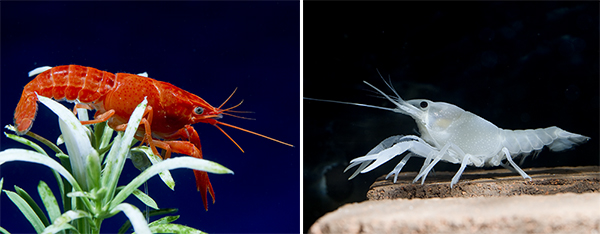Are you keeping an illegal crayfish? If you are, you risk a visit from the authorities to have your livestock confiscated. As a retailer, if you’re caught with the wrong species, you could lose your license to import any livestock at all, writes Nathan Hill.
The legal one
If you’re living in England or Wales there is one species of Crayfish you are allowed to keep for ornamental reasons— the Australian redclaw, sometimes called the Blue lobster, Cherax quadricarinatus. Which is pictured below.

That’s it. That’s the only one. A general license was issued under The Prohibition of Keeping of Live fish (Crayfish) Order 1996, which allowed the keeping of this species ornamentally within heated indoor aquaria only.
If you’re in Scotland it’s even simpler. There are NO ornamental freshwater lobsters or crayfish you are allowed to keep. Different legislation there prohibits them entirely.
The Australian redclaw is an obvious enough species to identify with a dappled blue shell and red (sometimes faded to orange) outer claws. This crayfish is a tropical-only species unable to breed if released into UK waterways, and is not known as a carrier of crayfish plague — in fact it is susceptible to it, as is our native White-clawed crayfish.
You can find a handy guide to identifying Redclaw crayfish on the OATA site right here: CLICK HERE
The illegal ones
The most common illegal species appearing in retailers is the Red swamp crayfish (usually offered just as Red crayfish/lobster), Procambarus clarkii. These Mexican/Southern USA crayfish are able to survive and reproduce in native waters in the UK, with feral populations being known at several sites in London. As well as carrying crayfish plague, they are vectors for a number of parasitic worms, as well as crayfish virus.
While the majority of Red swamp crayfish have stark red bodies (see below), there are also blue and orange variants, as well as a snow-white variant.

Another species appearing is the Marbled crayfish, Procambarus sp. This crayfish is immediately recognisable for its mottled brown shell (see below), which the Australian red-claw never possesses. This species is thought to be a form of the North American slough crayfish, Procambarus fallax. This species is able to reproduce without a male present, using asexual, parthenogenetic reproduction. Like the Red swamp crayfish, this species carries crayfish plague, although feral UK populations aren’t known at this time.

The law and you
As a hobbyist or retailer, keeping these crayfish could land you in hot water. While there is a loophole that allows for these animals to be kept in secured conditions in restaurants, markets and hotels, these are restricted to instances of the crayfish being intended for direct human consumption.
In some cases, individual licenses have been granted for educational, scientific or farming purposes, but only in secure facilities where the animals are unable to escape and access to them is limited.
What does this mean to you as a hobbyist if you have one at home? You need to report it to the Fish Health Inspectorate (FHI) either by emails on [email protected], or telephone 01305 206700. They will then seize the animal and take it away.
If you are found to be in possession of illegal crayfish and haven’t notified the FHI of them, they can and will still be seized.
What does this mean to you as a wholesaler or livestock importer? If you sell illegal crayfish your stock will be seized and you will be issued a warning. A repeat offence will lead to a final warning, and a third offence could lead to the FHI/CEFAS suspending or removing your authorisation to import and trade in all species.
On top of that, you may face a possible fine (the ILFA schedule shows that the maximum fine for illegal crayfish importation can be up to £2500).
The FHI can then interrogate your records to ascertain exactly where crayfish have been sold to before more formal warnings are issued.
Note that at a retail level, ignorance is no defence. While the FHI understand that some crayfish are difficult to speciate, and while they also understand that it is possible to order one thing from an importer/wholesaler and receive something else, they also stress that information and ID sheets are available to the industry.
If you have accidentally traded in these species, you must also alert any customers who have purchased them that they cannot keep them.
In brief
Do not buy any red, white or marbled crayfish (in England and Wales)
Do not buy any crayfish at all (in Scotland)
Report any red, white or marbled crayfish you see to the FHI on 01305 206700, or [email protected]
Do not release ANY crayfish into native waters







